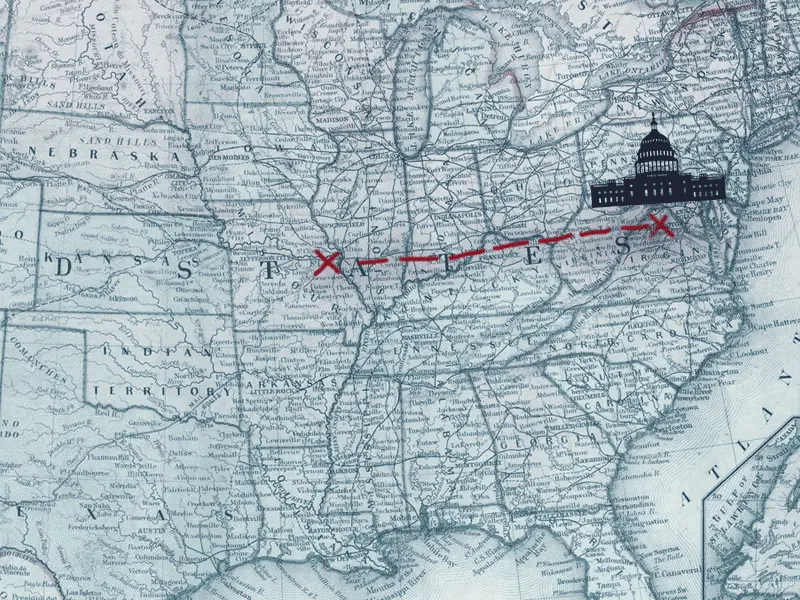U.S. Capitol
Jill Biden's Inaugural Attire Is on View at the Smithsonian
The day and evening ensembles are now the centerpiece of the American History Museum's popular "First Ladies" exhibition
Is This the End of D.C.'s Most-Beloved Hidden Landmark?
The fate of the stones that were once a part of the U.S. Capitol has locals despondent
Amelia Earhart Statue Finally Arrives at U.S. Capitol
After a 23-year delay, the statue will represent Kansas in the Statuary Hall Collection
A Brief History of Televised Congressional Hearings
From a 1951 investigation into organized crime to the Watergate scandal, the ongoing January 6 hearings are part of a lengthy political tradition
Archiving the January 6 Insurrection for History
On the one-year anniversary of the attack on the Capitol, the National Museum of American History continues to collect related artifacts
The Ill-Fated Idea to Move the Nation's Capital to St. Louis
In the years after the Civil War, some wanted a new seat of government that would be closer to the geographic center of a growing nation
Curators Seek $25,000 to Repair Artworks Damaged in U.S. Capitol Attack
Rioters vandalized six sculptures and two paintings, in addition to smashing windows, breaking furniture and spraying graffiti
The Tragic Irony of the U.S. Capitol's Peace Monument
An unfinished Civil War memorial became an allegory for peace—and a scene of insurrection
A Museum Curator Reports on Rapid-Response Collecting January 6 on Capitol Hill
National Museum of American History curator Frank Blazich discusses rapid-response collecting in the wake of the Jan. 6 riots at the U.S. Capitol.
Proactive Tips for Speaking With Children About Violence, Racism and Tragic Events
What do we tell children now? It's time to ask ourselves what we are going to say and do before the next time this happens
Smithsonian Educators Offer Tips for Talking to Children After a Traumatic Event
As details about traumatic events unfold in the news, it is important for families to navigate these conversations with young children with care.
Page 1 of 1
:focal(800x602:801x603)/https://tf-cmsv2-smithsonianmag-media.s3.amazonaws.com/filer_public/5d/ea/5dea5762-a2ab-4b2e-9648-35e1262ab4c5/gettyimages-1246529913.jpg)
:focal(960x640:961x641)/https://tf-cmsv2-smithsonianmag-media.s3.amazonaws.com/filer_public/f0/be/f0befb0f-63a0-46f7-af16-b68dca476523/gettyimages-1039815932.jpg)
:focal(469x370:470x371)/https://tf-cmsv2-smithsonianmag-media.s3.amazonaws.com/filer_public/1c/45/1c45eb9e-0344-4f8f-b083-cb25f3b4412b/2-amelia_earhart_1937-in_cockpit_of_electra.jpg)
:focal(2188x1247:2189x1248)/https://tf-cmsv2-smithsonianmag-media.s3.amazonaws.com/filer_public/fb/7f/fb7f92e8-7677-478f-bd29-17b2b624779a/gettyimages-515335156.jpg)
:focal(700x527:701x528)/https://tf-cmsv2-smithsonianmag-media.s3.amazonaws.com/filer_public/d3/d5/d3d51023-4d8b-4787-9aa8-ed7c9270f9a8/the_capitol_building_fenced_off_on_january_7.jpeg)

:focal(1846x1687:1847x1688)/https://tf-cmsv2-smithsonianmag-media.s3.amazonaws.com/filer/de/6f/de6f4946-58b4-448a-a01b-a320bc7ba415/gettyimages-1230453933.jpg)
:focal(749x335:750x336)/https://tf-cmsv2-smithsonianmag-media.s3.amazonaws.com/filer/dc/71/dc715c0f-0ef9-43e3-a2c5-08ffd9b77171/peacememorial10.jpg)
/https://tf-cmsv2-smithsonianmag-media.s3.amazonaws.com/filer/73/9a/739a6422-0ef6-4954-9621-f2f67ec5eefa/20210107_095357_1_ed.jpg)
/https://tf-cmsv2-smithsonianmag-media.s3.amazonaws.com/filer/03/fa/03fa9e2f-f115-4e34-8e5d-5faaf264fd93/jn2019-00362.jpg)
/https://tf-cmsv2-smithsonianmag-media.s3.amazonaws.com/filer/22/fc/22fccf9a-40e7-4249-8f49-d7b9a16f9fc3/gettyimages-1237929985.jpg)